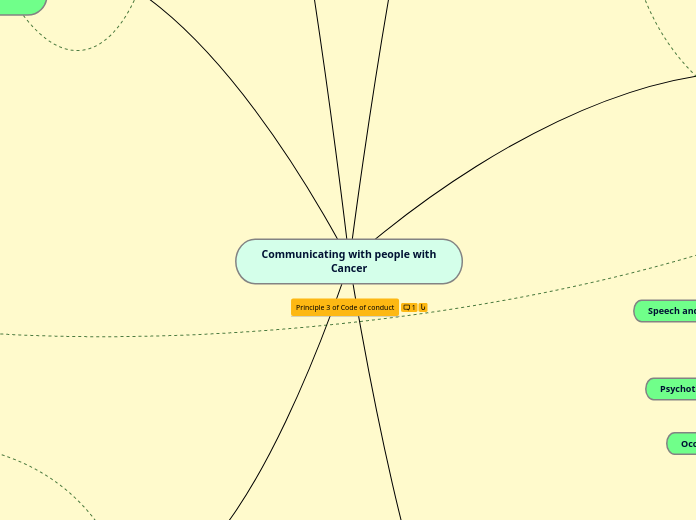Communicating with people with Cancer
Methods of communication
Verbal
Spoken words
Tone
Pitch
Volume
Non verbal
Posture
Gesture
Touch
Noises
Sigh
Cry
Written
Visual
Barriers to communication
Emotional
Shock
Sensitivity of topic
Privacy
Competing demands
Other patients
Business
Time ⏲
Health literacy
Audience
Message
Jargon
Images
Perceptual barriers
Perceptions
Overcome by
Knowledge
Cognition
Experience
Attitude
Emotion
Distractions outside workplace
Motives to one's behaviour
Labelling
Subconscious
Conscious
First/last impression
Relationship with Healthcare Professionals
Hospital
Curative
varying treatment regimen- less exposure
Palliative
Diagnosis
Out Patient
In Patient
End of life
Continual engagement with staff
Familly
Patient
Community
Physiotherapist
G.P
Public Health Nurse
Pharmacist
Resources Available
HSE & NCCP
Signposting
Guidance
Reasoning
Experienced Healthcare professionals
Areas of improvement
Overcome an obstacle
Co- Survivors
Post Treatment
Charities
Support
Survivorship
Coping mechanisms
Information
Treatment and side effects
Checking
Communicating with
Co-survivors
What do they need to know?
Family
Support groups
General health advice
Importance of vaccines
Increased hygeine measures
Looking after their
physical and mental health
Carers
Carers' Entitlements
Carer's Allowance
Carer's Benefit
Support groups
Information about medications
How to communicate it
Unlikely to reach out themselves
Brief interventions
Have leaflets available in the pharmacy
Communicating about
their Medicines
What type of medication?
Oral Anticancer Medicines
Parenteral therapy
Dosing instructions
Cyclical therapy
Daily therapy
Additional medications
and what to take when
Antiemetics
Laxatives
Antidiarrhoeals
Painkillers
Steroids
Side effects
What to expect
Aches and pains
Weakened immune system
Hair loss
Nausea and vomiting
How to Manage
Pain
Caution with paracetamol
May mask a fever
Opioids
Unexplained fevers
or other signs of infection
Immediate medical attention
Hair loss
Information on wigs etc
Support groups
Nausea and vomiting
Prescribed antiemetics
Non-pharmacological measures
